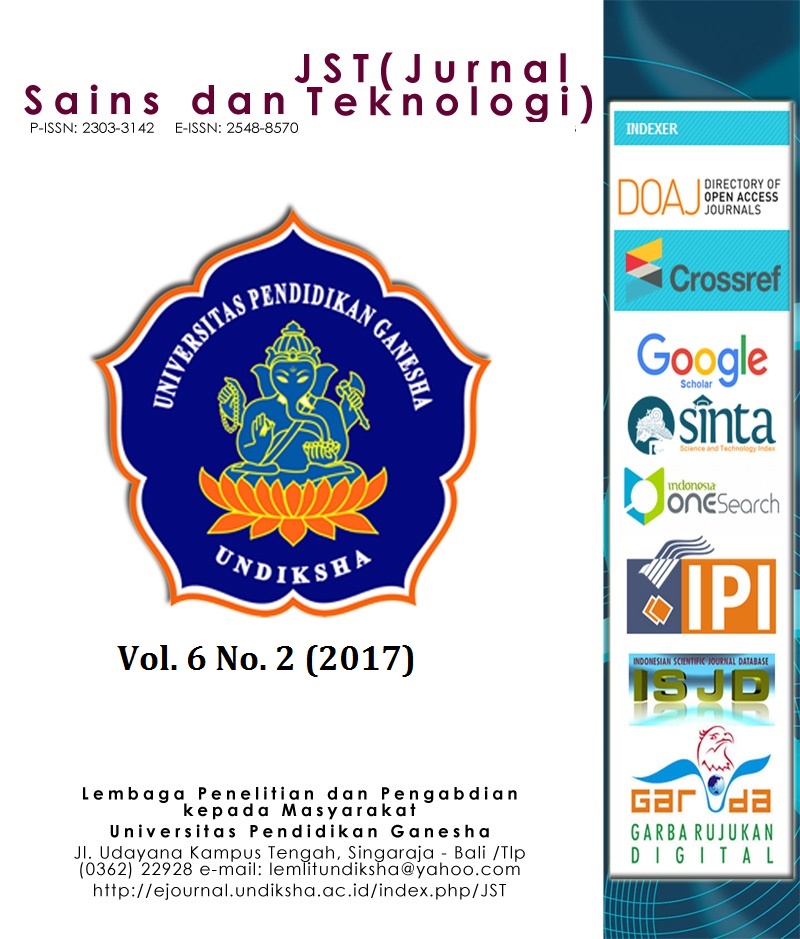PENGERINGAN TERASI LOKAL KARAWANG : SINAR MATAHARI – TRAY DRYER
DOI:
https://doi.org/10.23887/jstundiksha.v6i2.11867Keywords:
sinar matahari, terasi, tray dryer, udang rebonAbstract
Pembuatan terasi lokal Karawang masih memanfaatkan ketersediaan sinar matahari. Luas area penjemuran menjadi sorotan umum bila pengunjung melewati pemukiman TPI Ciparage. Udang rebon dihampar di pekarangan rumah pengrajin terasi. Ketidakbersihan proses yang berlangsung dan fluktuatifnya udara panas menginisasi kebutuhan teknologi sehingga saat ini dapat dijumpai pengering rak. Penggunaan tray dryer mulai dari bahan baku hingga terbentuknya produk terasi mampu mengurangi luas ruang pengeringan dan juga udara panas tersirkulasi secara merata. Perbandingan penurunan masa bahan per waktu antara sinar matahari dan alat tersebut belum memberikan hasil yang signifikan berbeda, tetapi terlihat nyata pada penampakan produk terasi. Pengoptimalan penggunaan seluruh rak dapat meningkatkan kuantitas produk terasi dan langkah mengatasi luas ruang pengering.
Kata kunci: sinar matahari, terasi, tray dryer, udang rebon
Abstract
Shrimp paste processing from Karawang still used the availability of the sun shine. Wide area of drying was being general highlight if visitor took around TPI Ciparage’s residence. Rebon shrimp was put in the producer’s yard. No hygiene on progress process and fluctuations of hot air pushed a technology. So nowadays researcher could have plan through tray dryer. Using of this machine from raw material until the shrimp pasted product could decrease the drying area and also hot air could be circulated evenly. The result showed that the sample mass by sun and tray dryer did not give a significantly difference, but not for the product’s sightings. Optimization of all of tray on the machine could improve the quantity of shrimp paste product and a way solved the wide area of drying.
Keywords : rebon shrimp, shrimp pasted, sun, tray dryer
References
Andriyani, E. A., Yuliati, K., & Supriadi, A. (2014). Efisiensi dan Identifikasi Loss pada Proses Pengolehan Terasi Udang Rebon (Acetes sp) di Desa Belo Laut Kecamatan Muntok Bangka Belitung. Jurnal Teknologi Hasil Perikanan, 1(1), 26–40.
Djaeni, M., Aishah, N., Nissaulfasha, H., & Buchori, L. (2013). Corn Drying with Zeolite in the Fluidized Bed Dryer under Medium Temperature. IPTEK, 24(2), 1.
Djaeni, M., Ayuningtyas, D., Asiah, N., Hargono, H., Ratnawati, R., Wiratno, W., & Jumali, J. (2013). Paddy drying in mixed adsorption dryer with zeolite: Drying rate and time estimation. Reaktor, 14(3), 173–178.
Djaeni, M., Prasetyaningrum, A., & Mahayana, A. (2012). Pengeringan Karaginan dari Rumput Laut Eucheuma cottonii pada Spray Dryer Menggunakan Udara yang Didehumidifikasi dengan Zeolit Alam. Momentum, 8(2). Retrieved from http://publikasiilmiah.unwahas.ac.id/index.php/MOMENTUM/article/view/428
Djaeni, M., & Sari, D. A. (2015). Low Temperature Seaweed Drying Using Dehumidified Air. Procedia Environmental Sciences, 23, 2–10. https://doi.org/10.1016/j.proenv.2015.01.002
Djaeni, M., Sasongko, S. B., Prasetyaningrum, A., Jin, X., & van Boxtel, A. J. (2012). Carrageenan Drying with Dehumidified Air : Drying Characteristics and Product Quality. International Journal of Food Engineering, 8(3). https://doi.org/10.1515/1556-3758.2682
Fudholi, A., Othman, M. Y., Ruslan, M. H., Yahya, M., Zaharim, A., & Sopian, K. (2011a). Design and Testing of Solar Dryer for Drying Kinetics of Seaweed in Malaysia. Recent Research in Geography, Geology, Energy, Environment and Biomedicine, 119–124.
Fudholi, A., Othman, M. Y., Ruslan, M. H., Yahya, M., Zaharim, A., & Sopian, K. (2011b). The Effects of Drying Air Temperature and Humidity on Drying Kinetics of Seaweed. Recent Research in Geography, Geology, Energy, Environment and Biomedicine, 129–133.
Kim, Y.-B., Choi, Y.-S., Ku, S.-K., Jang, D.-J., Ibrahim, H. H. binti, & Moon, K. B. (2014). Comparison of Quality Characteristics Between Belacan from Brunei Darussalam and Korean Shrimp Paste. Journal of Ethnic Foods, 1(1), 19–23. https://doi.org/10.1016/j.jef.2014.11.006
Maflahah, I. (2013). Kajian Potensi Usaha Pembuatan Terasi Udang Studi Kasus Desa Bantelan Kecamatan Batu Putih Kabupaten Sumenep. Agrointek, 7 No 2, 99–102.
Ma’ruf, M., Sukarti, K., Purnamasari, E., & Sulistianto, E. (2013). Penerapan Produksi Bersih pada Industri Pengolahan Terasi Skala Rumah Tangga. Jurnal Ilmu Perikanan Tropis, 18(2), 84–93.
Prasetyaningrum, A., & Djaeni, M. (2012). Drying Spirulina with Foam Mat Drying at Medium Temperature. Internatiol Journal of Science and Engineering, 3(2), 1–3.
Purtomo, T., Ratih, I. A. B., & Utomo, D. B. (2016a). IbM elompok Usaha Rumah Tangga Terasi Rebon di Lingkungan Pantai Teleng Kota Pacitan. JPM17: Jurnal Pengabdian Masyarakat, 2(01), 19–28.
Purtomo, T., Ratih, I. A. B., & Utomo, D. B. (2016b). IbM Kelompok Usaha Rumah Tangga Terasi Rebon di Lingkungan Pantai Teleng Kota Pacitan. JPM17, 2(01). Retrieved from http://jurnal.untag-sby.ac.id/index.php/jpm17/article/view/781
Rahayu, R. D., Purwono, E. H., & Sujudwijono, N. (2015). Perancangan Bangunan Industri Terasi di Tuban. Jurnal Mahasiswa Jurusan Arsitektur, 3(1). Retrieved from http://arsitektur.studentjournal.ub.ac.id/index.php/jma/article/view/69
Sulistiyono, S. T. (2014). Mengenal Sistem Pengetahuan, Teknologi, dan Ekonomi Nelayan Pantai Utara Jawa. AGASTYA: Jurnal Sejarah Dan Pembelajarannya, 4(02), 1–24.
Downloads
Published
How to Cite
Issue
Section
License
Authors who publish with the Jurnal Sains dan Teknologi (JST) agree to the following terms:
- Authors retain copyright and grant the journal the right of first publication with the work simultaneously licensed under a Creative Commons Attribution License (CC BY-SA 4.0) that allows others to share the work with an acknowledgment of the work's authorship and initial publication in this journal.
- Authors are able to enter into separate, additional contractual arrangements for the non-exclusive distribution of the journal's published version of the work (e.g., post it to an institutional repository or publish it in a book), with an acknowledgment of its initial publication in this journal.
- Authors are permitted and encouraged to post their work online (e.g., in institutional repositories or on their website) prior to and during the submission process, as it can lead to productive exchanges, as well as earlier and greater citation of published work. (See The Effect of Open Access)
















